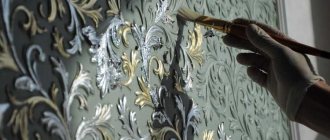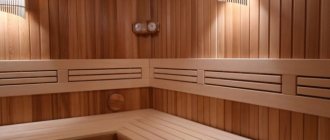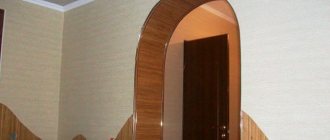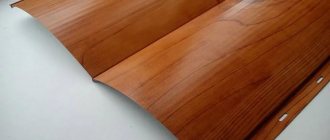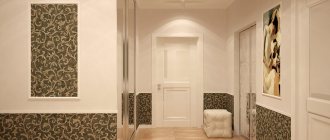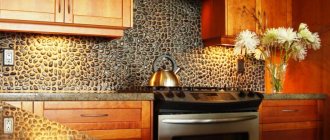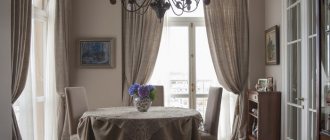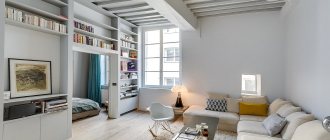At a certain stage of time, the owner of the apartment thinks about how to update the corridor so that it looks stylish. An alternative to wallpaper is painting the walls with enamel. Taking into account the small footage of the room, the method allows you to make the space larger and more modern. If you carry out the work yourself, then beginners often have difficulty choosing a dye, color, and method of manipulation. Skills are required to implement these construction activities. We'll tell you how to paint a corridor correctly, what enamel to choose, and tools. Let us explain the algorithm of preparatory work.
Benefits of painting walls
Upon entering the apartment, the first impression of the home and its owner is created. Each renovation and construction event is aimed at equipping and transforming the premises and its atmosphere. Painting work quickly “reformats” the hallway. The events have their advantages:
- The enamel used is odorless and dries quickly.
- There is always a wide selection of colors on the market.
- The enamel has no harmful fumes.
- You can actually do the work yourself.
- You can create the decor using a texture roller and a template.
- It is possible to create deep, varied shades from several colors (metallic, chameleon).
- There is no need to carry out extensive preparatory work, remove minor irregularities, or adjust patterns and joints. The dye adheres perfectly to the surface and smoothes it.
The technology allows you to create any composition. For wallpaper, the design is limited by the artist's imagination. And the range of paper products is formed based on the preferences of the seller.
Paint allows you to create any design on the wall
Features of the color scheme
Proper color design can solve many problems: visually expand the space, hide some defects, visually increase the height of the room. Considering that hallways are often small and dark, it is better to choose light and warm colors for them. Otherwise, there is a risk of getting the effect of non-residential premises.
Photo: Instagram idesing_spb
It’s better not to get carried away with dark tones; they visually make the room smaller. There shouldn’t be a lot of saturated and bright colors. They are best used as accents. It is better to select the color of furniture based on the walls and floor. Its tone should be combined with the shade of the flooring or walls or be contrasting.
Photo: Instagram mebelbos.by
Choosing a color for the corridor
By selecting the desired shade, we determine in what style the walls in the hallway will be decorated and what paint to use. There are several universal (basic) design concepts. You can paint the room according to the following schemes:
- Light shades. In a significant part of Russian apartments, the corridors are small in size and have an oblong, rectangular configuration. They do not have a natural light source (usually a lamp, halogen lamps). Therefore, it is better to use light, neutral colors when painting. Visually they will add volume to the room and expand it. In accordance with the concept, you can use: beige, milky, light coffee, golden colors.
- Glossy shades. The option involves expanding the space by creating a reflective surface. Glossy dyes conditionally increase the boundaries of the room and fill it with volume. The radiation flow from the lamps will create a unique artistic effect. This option will look good in rooms with low ceilings.
- Design of doorways. The method allows you to smooth out the negative effect in a narrow room. Doorways are finished in a dark, rich color, which creates a contrast that expands the boundaries of the room.
Pay attention to: What to do to speed up paint drying: various techniques to speed up drying time
The paint for the corridor is selected based on the characteristics. Water-based enamel is practical, inexpensive, easy to apply, and does not wear off for a long time. This dye is vapor-proof, so the apartment will have an optimal microclimate. Acrylic enamels can be used. They are convenient to work with, do not emit an unpleasant odor, and are environmentally friendly. They are produced mainly in white, but the color can be used to create any tone. Walls painted in light shades with acrylic paint look good. Such options were popular in the 90s.
Fashionable design solutions in 2021 (photo selection)
Let's look at the fashion trends in hallway design for this year:
- When creating the interior of a hallway, it is important to plan the arrangement of furniture. Since there are few free walls left, finishing plays a secondary role.
- Repair is made difficult by a large number of items. Be smart and embrace minimalism.
- Use no more than three colors for finishing: wood, white, gray or dark. Everything in the hallway has its own colors, for example, a wood floor, a snow-white ceiling, a dark rug. These colors are present in almost every interior. If you bring in bright colors, it will look pretentious and ridiculous.
- The hallway with built-in furniture and hidden LED lighting matches the fashionable design.
When decorating a small corridor, the priority should be neatness and functionality. Make the background in neutral colors, and we recommend choosing decorative plaster for finishing materials. It is reliable, stains are not visible on it, and is easy to clean. If you wish, you can choose wallpaper for painting or painting. If you have a spacious hallway or are planning a redevelopment, then the design will be completely different. For finishing you can choose several materials.
Textured surfaces add variety to the interior of a gray hallway. The texture can be created using decorative plaster.
When designing a corridor, its functionality comes first, and its elegant appearance, comfort, and convenience come second. It is important to observe moderation in everything.
Selecting tools
To quickly and beautifully paint the hallway, you will need a set of construction tools. To work you will need:
- Several brushes and rollers of different widths.
- Containers (containers) for enamel.
- Two spatulas (large and small).
- Putty and primer.
- Paint of your choice, color.
- Scraper, brush.
- Bulgarian.
- Sandpaper.
But you will also need a solvent. White spirit is added to the enamel if it thickens, making it more liquid and easier to apply. The solution will allow you to clean the surface of the skin and instruments if they become dirty. A few more dry rags will come in handy for working with natural fabric.
Tool required for work
Plastic panels on the walls of the hallway
Very often, plastic panels are used to cover hallway walls. This material is budget-friendly and comes in a wide range of designs and colors.
The interior of the hallway walls can be made to suit any style using plastic panels. Covering walls with this material is quite simple and easy; you don’t need to level or prepare the walls much. Plastic panels can be cleaned wet, but it is worth noting that they quickly fade when exposed to direct sunlight, and they can also be easily damaged.
Preparing the walls for painting
In order for repair operations to be completed successfully, the surface must be prepared. Painting the walls in the corridor involves working with as smooth an area as possible so that the dye adheres perfectly and does not emphasize unevenness. Preparatory activities are carried out according to the following algorithm:
- The old covering is dismantled. The paint is removed with a solvent and a scraper. To remove wallpaper you will need a grinder with a wire brush. You can also use a spatula and water.
- A thorough inspection of the cleaned surface is carried out to identify flaws. They can be removed using putty and a spatula. The peeling plaster is beaten off, and the cracks that appear are sealed with a solution of cement and putty.
- Then the surface is leveled using gypsum putty. Then you should wait until it dries.
- We treat the surface with a finishing putty mixture.
- After drying with a grater and sandpaper, the workspace is rubbed and sanded to perfect smoothness.
- Dust is removed with a vacuum cleaner. A rag removes debris.
- A primer is applied to the surface for painting.
Please note: How to paint a hot water tank
After the preparatory work, the “soil” should be allowed to dry. Then you can move on to basic manipulations.
The first step is to remove the old coating
If necessary, the walls are leveled and then primed
How to paint the walls in the corridor: photos that are worth taking into account
Painting walls is one of the fastest and easiest ways to decorate a room and make long-awaited renovations.
However, this can be done in several ways:
- Through a variety of textures;
- Monogamous;
- Using several colors or shades.
There are simply no specific patterns, fashion trends or canons in this matter. Each homeowner chooses exactly the option that seems most attractive to him.
In order not to make a mistake with the design, it is important to think about what you would like to see in the end: a calm interior or a room with very bright accents. This desire will have to be built on in the future. Most often, corridors are painted in neutral shades, which perfectly harmonize with any interior. If desired, the boring atmosphere can be diluted with bright accessories and household items.
It often happens that inspiration does not come by itself, so it can be borrowed from the works of specialists. Their photo offers are probably freely available, so finding the right option among them will not be difficult. Such imitation will definitely be beneficial! However, you always need to make your own modifications to it. Then the design will look truly exclusive.
Painting stage
Activities are carried out in the following order:
- masking tape is used to create smooth boundaries and cover adjacent areas from contamination;
- The first layer is applied (you can use a brush). The entire space is carefully and carefully painted over;
- wait until the enamel dries;
- The second layer is applied with a roller. After it dries, you can apply a third one;
- The walls take 12 hours to dry.
When the area is large, it is better to use a spray gun. It doesn't leave streaks and paints quickly. The enamel should be applied at an angle using this device. There are several technological methods for creating drawings. Before painting the walls in the corridor, we choose the option of applying the dye. The “patchwork” style involves marking the surface into rectangles and squares. The borders are sealed with masking tape. The formed figures are painted over with paint of different colors. The tape is removed and the edging is tinted a darker shade. The “combination” technique involves dividing the color of the walls into two levels. The lower one is painted over with a rich tone, and the upper one with a light tone. The levels are located horizontally or vertically relative to the floor.
Attention! The color should be added slowly, to the entire enamel at once, so that an ideal, high-quality, even shade is formed.
Using masking tape to separate and protect elements
Interior designer tips
Designer services are an expensive pleasure, and it is fortunate that extensive experience in such matters allows us to collect expert advice into a specific list that everyone has access to. Specific situations require an individual approach, but a generalized set of tips is no less useful when working independently (and working with experts in some situations).
- Pay attention to the correct painting option. This includes the principle of application, type of material, color. The chosen option is an idea to competently brighten up the shortcomings and emphasize the advantages of the hallway.
- A small, cramped room is a platform for using all possible methods of visual expansion. In the corridor, they use light colors, shiny and mirror surfaces, and “mirroring” spaces on opposite walls.
- Creating stencils is always relevant, easy, and helps to distinguish yourself with individuality and uniqueness. The reason they are not recommended is the inability to match them to the overall look of the interior. Knowing this aspect, it is realistic to experiment with this technique.
Interesting! For stencils, use thick plastic film, thick paper or cardboard. In some cases, wallpaper is used.
- A sufficient amount of space allows you to use several colors - even the entire rainbow, if you can fit it in correctly. Colors divide spaces into zones. In the hallway, passage zones are distinguished.
Interior

